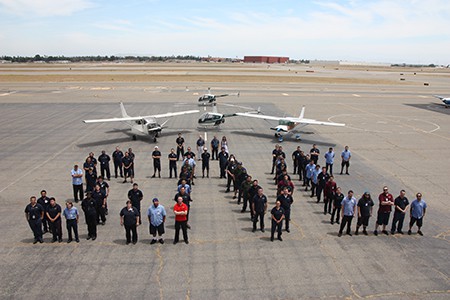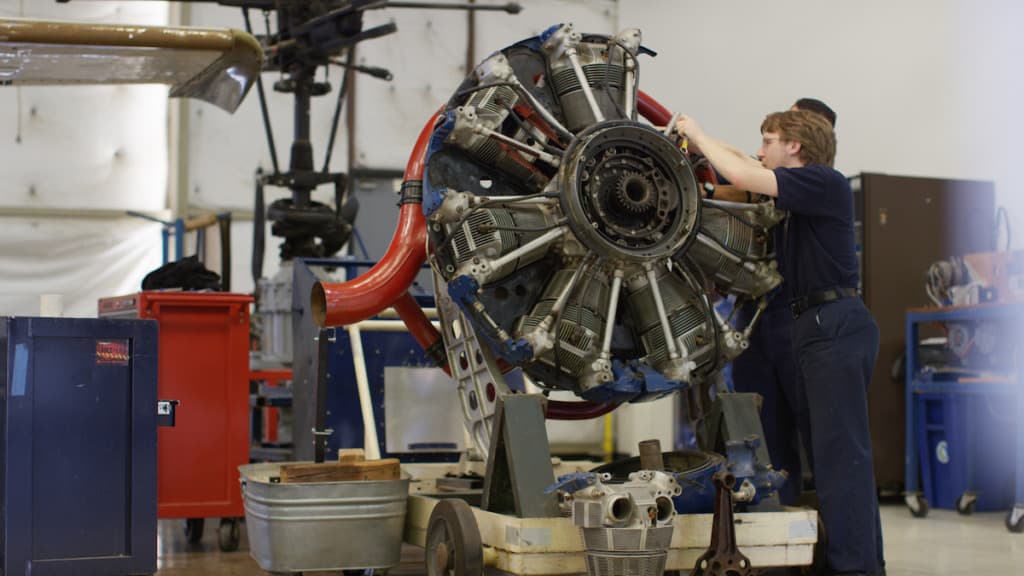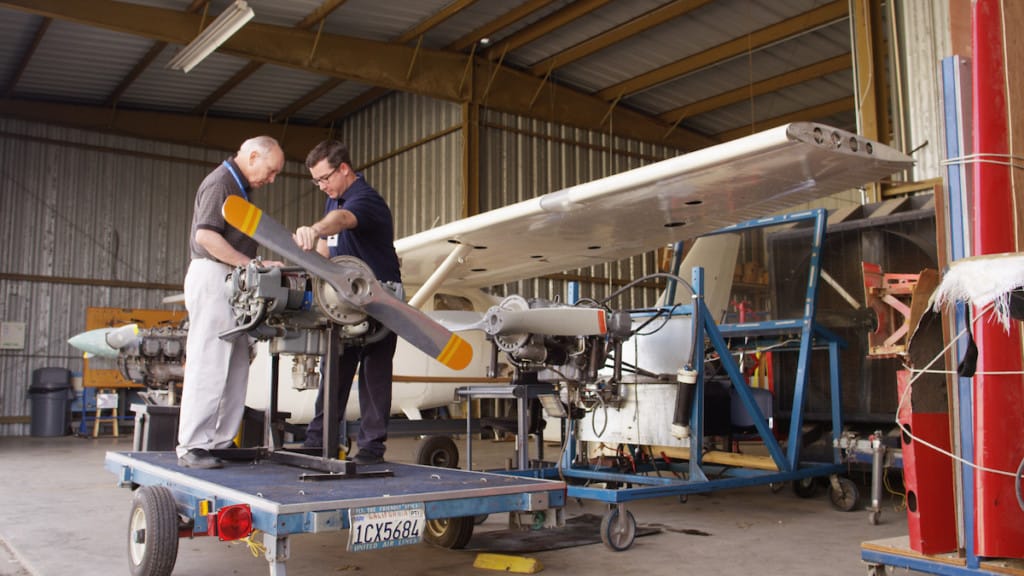Aviation Maintenance Technology program celebrates 30 Years in Fresno
Thirty years ago, there was more going on than those flash-fads of parachute pants, beanie babies and Macarena performances. A growing interest in the community for a high-end career as a well-trained aircraft mechanic caught the interest of San Joaquin Valley College.
 The big aircraft companies and carriers at that time, such as Tran World Airlines (TWA), United Airlines, Continental Airlines and Pan American World Airways (Pan Am) mostly recruited skilled mechanics from big city training facilities. San Joaquin Valley College’s research verified an industry need and a local interest in an Aviation Maintenance Technology career training resource. In the summer of 1991, SJVC launched its Aviation Maintenance Technology (AMT) program on the extended grounds of the Fresno Airport (now Fresno Yosemite International Airport) with just a handful of students. The AMT program stays steady today with almost 900 graduates prepared for this specialty field.
The big aircraft companies and carriers at that time, such as Tran World Airlines (TWA), United Airlines, Continental Airlines and Pan American World Airways (Pan Am) mostly recruited skilled mechanics from big city training facilities. San Joaquin Valley College’s research verified an industry need and a local interest in an Aviation Maintenance Technology career training resource. In the summer of 1991, SJVC launched its Aviation Maintenance Technology (AMT) program on the extended grounds of the Fresno Airport (now Fresno Yosemite International Airport) with just a handful of students. The AMT program stays steady today with almost 900 graduates prepared for this specialty field.
The AMT program’s original stand-alone campus is now the Fresno – Trades Education Center (TEC) and expanded to include Heating, Ventilation, Air Conditioning & Refrigeration (HVAC-R), Electrical Technology and Maintenance Technician programs. “Although we’ve partnered up with the ‘technical campus’, we like to keep our individual identity, also,” says Curtis MacNeill, Fresno – TEC Campus Dean.
The AMT’s Certificate program, which can be completed in as few as 17 months, is offered 7:00 AM – 3:30 PM Monday through Thursday and combines classroom education and exchange with hands-on experience in the program’s expansive hangar where students put their newly acquired knowledge to practical application.
 The hangar houses an array of aircraft and essential parts, including body, engine and wing sections, where students use tools necessary to their trade to demonstrate their problem-solving knowledge. Aircraft in various stages of inoperable-to-functional challenge students to prove them viable.
The hangar houses an array of aircraft and essential parts, including body, engine and wing sections, where students use tools necessary to their trade to demonstrate their problem-solving knowledge. Aircraft in various stages of inoperable-to-functional challenge students to prove them viable.
In recent years, the AMT program has peaked at 100-plus students at any one time. Although the recent pandemic reduced enrollment size temporarily, enrollments are now on the incline.
One of the strongest components of the AMT program is its close affiliation with employers in the industry, many of whom generously provide classroom presentations that outline industry needs as they enthusiastically recruit students about to graduate. Representatives and recruiting staff from SkyWest Airlines, Northrop Grumman, Virgin Galactic, Scaled Composites, The Spaceship Company, Tyoneck Manufacturing Group, Papillon Helicopters, Columbia Helicopters and many others regularly visit the AMT program campus and enjoy that dynamic of information and career opportunity exchange.
“SkyWest Airlines is our biggest employer,” says Sue Montgomery, Director of Institutional Partnerships. “They are invited to campus to do our in-person presentations at least three times a year. They have hired over 90 of our graduates over the past 30-years.”
SkyWest’s endorsement of SJVC’s AMT program and student success is more than conversational. “SkyWest Airlines has promoted our college on their employment website for many years now as a partner school for them to hire A&P (Airframe and PowerPlant) Mechanics,” says Sue.
 “SJVC’s AMT program’s reputation in the aviation community is among the highest in the area,” says Curtis. There is a very good reason. “They (employers) are confident we are providing them with competent, well-trained employees. The graduates we send them are the kind they want more of.”
“SJVC’s AMT program’s reputation in the aviation community is among the highest in the area,” says Curtis. There is a very good reason. “They (employers) are confident we are providing them with competent, well-trained employees. The graduates we send them are the kind they want more of.”
It works from both ends. “And our graduates are confident that working for them is the best thing they can do to forward their careers,” says Curtis.
SJVC’s AMT program also benefits very directly from graduate experience and success out in the field. “We have hired back many of our previous AMT grads (after they have spent several years in the aviation industry) to be instructors for our college,” says Sue.
There is not a specific profile of students who are sure to do well in the AMT program. Men and women do equally well; mechanical experience might be helpful, but is not necessary, and age, size and work experience seem not to play a significant role in who might be successful in an aviation maintenance technology career. With one possible exception.
“You have to have the desire to be in this field – and the ability to pay attention to detail,” says Curtis. “In this industry you have to record every detail of repair. There is a document or log to track every repair, maintenance service, procedure, equipment/parts and the tools you used. And, everything has to be done according to the book, with the maintenance manual out in front of you – even if you’ve done it a thousand times in your career. When it comes to aircraft repair, the stakes are high. Oh, and you can’t be afraid to get your hands dirty.”
Of the dozens who joined in the Fresno AMT Open House celebration of the program’s 30th anniversary recently, a half dozen – with no previous experience – tried that potential career on for size. “We invited attendees to start up engines out on the tarmac (that were chained down to counter thrust), hit the ignition and change the throttle,” says Curtis. “It is quite a loud experience.”
A dozen or so expressed an interest in a career in aviation maintenance. Within a month some of the fresh-faced enthusiasts had enrolled.
San Joaquin Valley College’s Aviation Maintenance Technology program is looking forward to many more years of propelling well-trained AMT professionals into the field of their life’s ambition, as it continues to serve the expansive aviation/aeronautics industry.
Learn More About A Career as an Aircraft Mechanic
Find out more about the different kinds of aircraft maintenance jobs, what they do, salary possibilities and more facts you need to begin your aircraft mechanic training.
You might also like
More stories about
Request Information
All fields using an asterik (*) are required.


